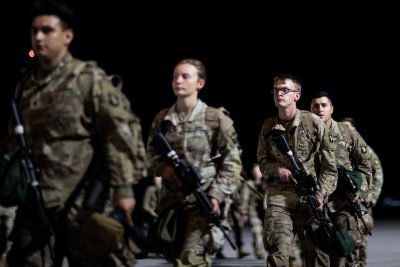101st Airborne Still Deployed in Romania Simulating War with Russia
Members of the division told CBS in October that they were prepared to enter Ukraine if given the order

All Global Research articles can be read in 51 languages by activating the Translate Website button below the author’s name.
To receive Global Research’s Daily Newsletter (selected articles), click here.
Follow us on Instagram and Twitter and subscribe to our Telegram Channel. Feel free to repost and share widely Global Research articles.
***
About 4,000 members of the US Army’s 101st Airborne Division are still deployed in Romania as part of a military buildup in Eastern Europe that President Biden ordered last year, as the Pentagon is still deciding whether to maintain current troop levels.
The New York Times reported Tuesday that some 101st soldiers are stationed at a base near the Romanian city of Constanta on the Black Sea while others are further north, just a few miles from the Ukrainian border, and are simulating fighting Russia in Ukraine.
In exercises with Romanian troops, the Times report said the 101st soldiers are firing artillery, launching helicopter assaults, and digging trenches similar to those on the front lines in Ukraine’s Kherson Oblast.
The deployment marks the first time the 101st has been sent to Europe since World War II.
CBS News reported in October that the 101st was conducting drills within just four miles of the Ukrainian border and that the unit was prepared to “fight tonight.” Commanders told CBS that they were in Romania to protect NATO territory but said they were ready to enter Ukraine if the war escalated.
The Times report stressed that the 101st Airborne deployment was about deterrence. If the US were preparing to enter the war directly, it would likely send significantly more troops. While in Romania, the soldiers are also participating in coastal defense drills, and Romanian troops are practicing firing HIMARS rocket launch systems into the Black Sea.
The military buildup in Eastern Europe has brought US troop levels on the continent to over 100,000 for the first time since 2005. The Pentagon is expected to decide soon if it will maintain the current levels for the long term or reduce or increase them.
The over $100 billion that has been authorized to spend on the war in Ukraine includes money to fund troop deployments in Europe. The latest Ukraine aid bill that was passed by Congress includes $6.98 billion for US European Command, which will likely fund the training of Ukrainian troops, other types of support for Kyiv, and US deployments in the region.
*
Note to readers: Please click the share buttons above. Follow us on Instagram and Twitter and subscribe to our Telegram Channel. Feel free to repost and share widely Global Research articles.
Dave DeCamp is the news editor of Antiwar.com, follow him on Twitter @decampdave.
Featured image: Army soldiers assigned to the 101st Airborne Division arrive in Mihail Kogalniceanu, Romania, Jun. 28, 2022. Units from the 101st will support the Army’s V Corps’ mission to reinforce NATO’s eastern flank and engage in multinational exercises with partners across Europe to reassure allies and deter further Russian aggression. (Photo by Army Capt. Angelo Mejia)

